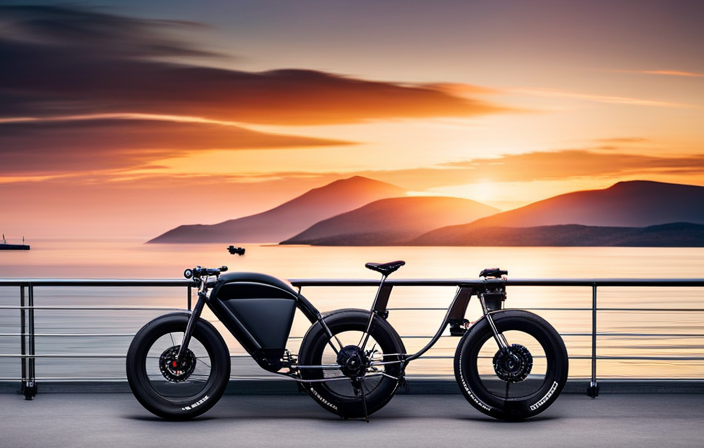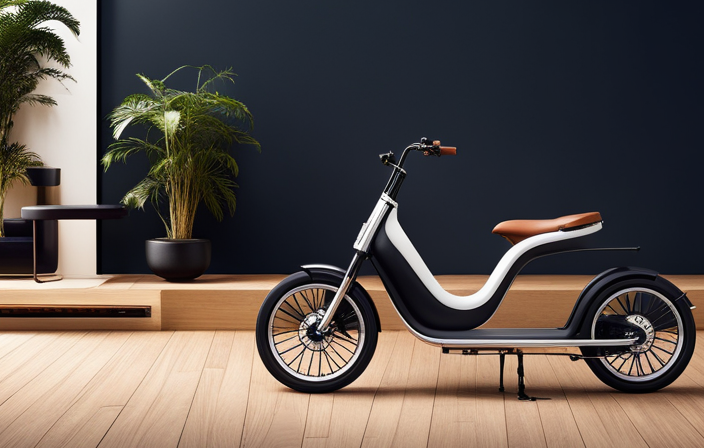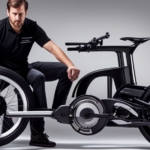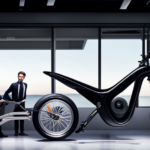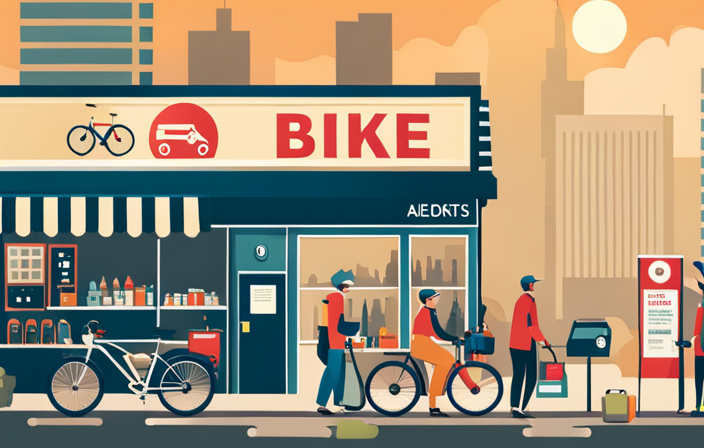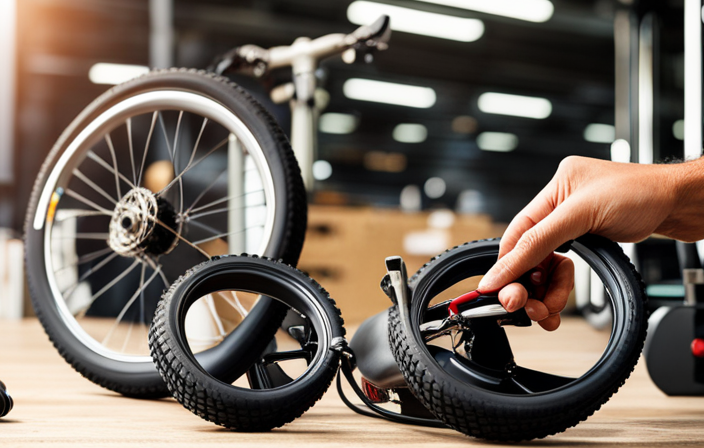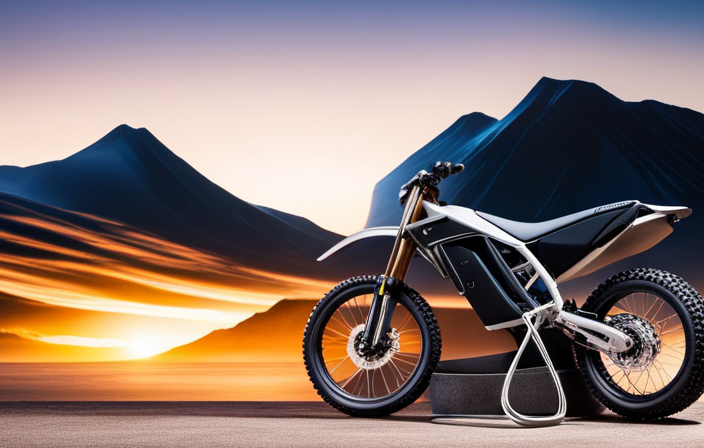You might think that building an electric bike is a complex and daunting task. However, with the right components, it can be a rewarding and fulfilling project.
In this article, we will guide you through the essential components needed to construct your own electric bike. From choosing the right frame and motor to understanding the battery type and controller, we will provide you with the technical and precise information you need to successfully assemble and test your electric bike.
Key Takeaways
- E-bike speed and power control
- Selecting the display and controls
- Deciding on the lighting system
- Choosing the right tires
Choosing the Right Frame
You’ll need to choose the right frame for your electric bike. When selecting a frame, it is important to consider the materials used and the size that best suits your needs.
The frame materials can greatly impact the performance and durability of your electric bike. Aluminum frames are lightweight and offer good strength, making them a popular choice. Steel frames, on the other hand, provide excellent durability and stability but can be heavier. Carbon fiber frames are known for their strength and lightness, but they tend to be more expensive.
As for frame size, it is crucial to find one that fits you comfortably and allows for proper leg extension.
Once you have selected the right frame, you can move on to selecting the motor, which will be discussed in the subsequent section.
Selecting the Motor
To choose the motor for your electric bike, consider its power and compatibility. The motor power determines how fast and efficiently your bike will run. Look for motors with higher power ratings, such as 750W or 1000W, for better performance. Additionally, motor efficiency is crucial as it affects the range of your bike. Opt for motors with high efficiency ratings to maximize battery life and extend your riding distance.
When selecting a motor, keep in mind the compatibility with your bike’s frame and other components. Ensure that the motor you choose fits properly and aligns with the specifications of your bike. With a powerful and efficient motor, you can enjoy a smooth and exhilarating ride on your electric bike.
Moving on to deciding on the battery type…
DECIDING ON THE BATTERY TYPE
Deciding on the Battery Type
When deciding on the battery type, it’s important to consider factors such as power output and capacity to ensure optimal performance for your electric bike. There are different types of battery chemistries available for electric bikes, each with its own pros and cons.
One common type is the lithium-ion battery, which offers high energy density, longer lifespan, and lightweight design. Another option is the lead-acid battery, which is more affordable but has a lower energy density and shorter lifespan. Nickel-metal hydride batteries are also an option, offering a good balance between cost, energy density, and lifespan.
It’s important to note that different battery types will have varying charging requirements and maintenance needs. Understanding the pros and cons of each battery type will help you make an informed decision for your electric bike.
Moving on to the next section, understanding the controller…
Understanding the Controller
Understanding the controller is essential for optimizing the performance of your electric bike. The controller acts as the brain of the electrical system, regulating the flow of power from the battery to the motor. It not only controls the speed of the bike but also monitors and protects the battery from overcharging or discharging.
Understanding the wiring system is crucial as it allows you to connect the controller to the battery, motor, throttle, and other components correctly. Exploring different types of controllers is important, as they come in various sizes, power ratings, and functionalities. Some controllers offer additional features like regenerative braking or LCD displays for monitoring battery levels and speed.
By understanding the controller and its role in the electrical system, you can make an informed decision when picking the right wheel size for your electric bike, ensuring a seamless integration of all components.
Picking the Right Wheel Size
Choosing the appropriate wheel size is crucial for optimizing the performance of your e-bike. When it comes to wheel size comparison, larger wheels offer several benefits that you should consider.
Firstly, larger wheels provide better stability and a smoother ride, especially when tackling rough terrain or uneven surfaces. They also have a larger contact patch with the ground, resulting in improved traction and better handling.
Additionally, larger wheels tend to roll over obstacles more easily, reducing the impact on the rider and increasing overall comfort. However, it’s important to note that larger wheels may also increase the weight and bulkiness of your e-bike.
As you move on to selecting the brakes, you’ll need to carefully consider the impact of the chosen wheel size on your braking system.
Selecting the Brakes
To select the brakes for your e-bike, you should consider the type of terrain you will be riding on and your personal riding style. Electric brakes are powered by the motor and provide a smooth and consistent braking experience. They offer precise control and require less maintenance compared to mechanical brakes. On the other hand, mechanical brakes are cable-operated and rely on physical force to stop the bike. They are simpler in design and generally more affordable.
When it comes to the braking mechanism, you have the option of disc brakes or rim brakes. Disc brakes provide powerful and reliable stopping power, especially in wet conditions. Rim brakes, on the other hand, are lighter and easier to maintain, but may not offer the same level of stopping power. Consider these factors when choosing the brakes for your e-bike.
Now, let’s move on to selecting the suspension system.
Choosing the Suspension System
Consider your riding style and the type of terrain you will be traversing when selecting the suspension system for your e-bike. The electric bike suspension is a crucial component that ensures a comfortable and smooth ride. There are various types of suspension systems available, including front suspension, full suspension, and rigid suspension.
Front suspension, also known as a hardtail, provides suspension only in the front fork, suitable for lighter off-road trails and urban commuting. Full suspension, on the other hand, includes both front and rear suspension, offering better control and stability on rough terrains and mountain trails. Lastly, rigid suspension, as the name suggests, lacks any suspension and is ideal for smooth roads and city riding.
Choosing the right suspension system for your e-bike depends on factors such as your riding preferences, the level of comfort you seek, and the type of terrain you regularly encounter.
Now that you have considered the suspension system, let’s move on to deciding on the drive system.
Deciding on the Drive System
When deciding on the drive system for your e-bike, you should think about your preferred riding experience and the type of terrain you’ll be tackling. The drive system is responsible for converting the power from the battery into motion, so choosing the right one is crucial. There are various drive systems available, each with its own advantages and limitations. To help you make an informed decision, let’s compare three popular options in the table below:
| Drive System | Pros | Cons |
|---|---|---|
| Hub Motor | Simple design, easy maintenance | Limited torque and hill-climbing ability |
| Mid Drive | Better weight distribution, suitable for steep terrains | Higher cost, complex installation |
| All-wheel Drive | Superior traction, great for off-road riding | Higher energy consumption, increased weight |
Considering these factors, you can select the drive system that aligns with your needs and preferences. Now, let’s move on to understanding the throttle and pedal assist system, which plays a crucial role in controlling your e-bike’s speed and power.
Understanding the Throttle and Pedal Assist System
Now, let’s dive into how the throttle and pedal assist system work to control your e-bike’s speed and power.
The throttle is a hand-controlled device that allows you to accelerate without pedaling. It is responsible for determining the amount of power the motor delivers. Throttle sensitivity can be adjusted to suit your preferences, giving you more control over your speed.
On the other hand, the pedal assist system provides assistance to your pedaling efforts. It works by detecting the torque you apply to the pedals and then amplifying it with the motor’s power. Most e-bikes come with multiple pedal assist levels, allowing you to choose the level of assistance you desire.
Understanding and fine-tuning both the throttle and pedal assist system are crucial for achieving the desired riding experience.
Now that you know how the speed and power are controlled, let’s move on to selecting the display and controls for your e-bike.
Selecting the Display and Controls
To choose the right display and controls for your e-bike, you should first determine your preferences and desired level of convenience. Start by evaluating the user interface of different options available in the market. Look for displays that are easy to read and understand while riding. Consider if you prefer a simple LCD display or a more advanced color screen with additional features.
Next, compare control options such as buttons, switches, or touchscreens. Think about which type of control you find most intuitive and comfortable to use while riding.
Once you have evaluated the user interface and compared control options, you can make an informed decision on the display and controls that best suit your needs.
Moving on to deciding on the lighting system…
Deciding on the Lighting System
Consider your visibility and safety by selecting a suitable lighting system for your e-bike. When deciding on the lighting system, you need to take into account the wiring options and battery placement. The wiring options will determine how the lights are connected to the e-bike’s electrical system. You can choose between integrated wiring, where the lights are directly connected to the main battery, or separate wiring, where the lights have their own independent battery.
The battery placement is also crucial as it affects the overall balance and weight distribution of the e-bike. It is recommended to opt for a lighting system that is easy to install and maintain, while also providing sufficient illumination for both the front and rear of the e-bike.
Now, let’s move on to choosing the right tires for your electric bike.
Choosing the Right Tires
When choosing the right tires for your e-bike, it’s important to consider factors such as terrain, weather conditions, and desired performance. The type of tires you choose can greatly impact the overall riding experience.
One important decision to make is whether to go for tubeless or tubed tires. Tubeless tires, while pricier, offer benefits such as reduced weight and improved puncture resistance. On the other hand, tubed tires are more affordable and easier to repair.
Another factor to consider is the tire material, as it affects performance. For example, tires made of softer compounds provide better grip but wear out faster, while harder compounds offer increased durability but may sacrifice traction.
As you select the right tires for your e-bike, keep in mind that the tire choice will influence the subsequent section about selecting the gearing system.
Selecting the Gearing System
The gearing system on your e-bike plays a crucial role in optimizing your riding experience. When selecting the gearing system for your electric bike, there are several factors to consider. One option to consider is the belt drive system, which offers a number of advantages. It is quieter, requires less maintenance, and provides a smoother and more efficient ride. However, it can be more expensive and less durable compared to a chain drive system. Another important factor to consider is the gear ratio. The gear ratio determines the relationship between the number of teeth on the front and rear gears, affecting the bike’s speed and power. A higher gear ratio allows for faster speeds but requires more effort, while a lower gear ratio provides more power but limits top speed. Understanding these factors will help you choose the optimal gearing system for your electric bike. Transitioning into the subsequent section about understanding the charging system, it is essential to consider the various charging options available for your e-bike.
Understanding the Charging System
Understanding how the charging system works is crucial for maintaining and maximizing the battery life of your e-bike. The charging system is responsible for replenishing the energy in your battery pack, so it is essential to keep it in optimal condition. Regular charging system maintenance is necessary to ensure its efficiency and longevity.
To maintain the charging system, start by inspecting the charger for any signs of damage or wear. Check the charging cables and connectors for any loose connections or frayed wires. Clean the contacts regularly to ensure a good connection between the charger and the battery pack.
Charging system efficiency is also crucial for getting the most out of your e-bike. Make sure to use a charger that is specifically designed for your battery pack to avoid overcharging or undercharging. It is recommended to charge your battery pack at its recommended voltage and current levels to optimize its performance.
By understanding and maintaining the charging system, you can ensure that your e-bike’s battery life is maximized. Now, let’s move on to assembling and testing the electric bike.
Assembling and Testing the Electric Bike
Now that you understand the charging system, it’s time to move on to the next step: assembling and testing the electric bike.
Assembling an electric bike requires careful attention to detail and specific techniques to ensure optimal performance. Here are some important points to consider:
-
Frame assembly: Properly align and attach the frame components, ensuring stability and durability.
-
Motor installation: Securely mount the motor onto the frame, ensuring proper alignment and connection to the drivetrain.
-
Battery integration: Safely install the battery pack, making sure to connect it to the motor and charging system.
-
Wiring management: Organize the electrical wiring, ensuring proper insulation and connection to all components.
-
Performance testing: Before hitting the road, thoroughly test the electric bike’s performance, including speed, range, and battery life.
By following these assembling techniques and conducting comprehensive performance testing, you can ensure that your electric bike is built to deliver optimal performance and reliability.
Frequently Asked Questions
Can I use any type of frame to build an electric bike?
Yes, you can use a road bike frame for an electric bike. However, there are some restrictions on using a specific type of frame.
The frame must be able to accommodate the additional weight and size of the electric components, such as the battery and motor. It should also have strong and sturdy construction to handle the increased power and torque.
Additionally, the frame should have mounting points for the battery, motor, and other necessary components.
What are the different types of motors available for electric bikes?
When comparing brushless and brushed motors for electric bikes, there are several factors to consider.
Brushless motors offer higher efficiency, longer lifespan, and smoother operation compared to brushed motors. However, brushed motors are generally cheaper and simpler in design.
When it comes to hub motors versus mid drive motors, hub motors provide easier installation, simpler maintenance, and better low-speed torque. On the other hand, mid drive motors offer better weight distribution, improved hill climbing ability, and a more natural riding experience.
How long does the battery typically last before needing to be replaced?
On average, the battery lifespan of an electric bike ranges from 2 to 5 years before needing replacement. This duration is influenced by various factors such as usage frequency, charging patterns, and overall battery quality.
It’s important to note that the battery replacement cost can vary depending on the type and capacity of the battery. Regular maintenance and proper charging habits can help maximize the battery’s lifespan and delay the need for replacement.
What functions does the controller perform in an electric bike?
The controller in an electric bike performs various crucial functions. It acts as the brain of the system, regulating the flow of electricity from the battery to the motor.
It controls the speed, assists in acceleration, and allows for regenerative braking. Additionally, the controller ensures the efficient use of power, monitors battery levels, and provides safety features like overcurrent protection.
Given its importance, the controller is a vital component in the functioning and performance of an electric bike.
Can I use any type of tire for my electric bike?
Yes, you can use different types of tires for your electric bike. Electric bike tire options include traditional road tires, hybrid tires, and off-road tires. The choice of tire depends on the terrain you will be riding on.
For example, if you will mainly ride on smooth roads, road tires would be suitable. On the other hand, if you plan to ride off-road, off-road tires with thicker treads would provide better traction. Ultimately, the tire choice should be based on your specific riding needs and preferences.
Additionally, when considering frame types for electric bikes, there are several advantages to certain options. For instance, a step-through frame allows for easier mounting and dismounting, making it ideal for riders with limited mobility or those who frequently stop and start.
A rigid frame provides stability and better power transfer, especially for higher speeds. Finally, a full-suspension frame offers improved comfort and control on rough terrains.
Conclusion
Congratulations! You’re now equipped with all the knowledge to create your own electric bike.
With the right frame, motor, battery, controller, wheel size, tires, gearing system, and charging system, you can assemble and test your masterpiece.
But beware, this is not a task for the faint of heart. It requires technical precision and analytical thinking.
So, put on your lab coat, grab your tools, and prepare to embark on a journey of electrifying proportions.
Happy biking!
